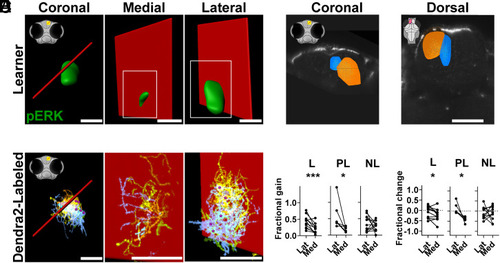Fig. 6
- ID
- ZDB-FIG-230204-39
- Publication
- Dempsey et al., 2022 - Regional synapse gain and loss accompany memory formation in larval zebrafish
- Other Figures
- All Figure Page
- Back to All Figure Page
|
Anatomical correlation of regions of increased neuronal activity and synaptic gain following TFC. (A) Coronal (Left), dorsomedial (Middle), and ventrolateral (Right) views of the region of increased pERK labeling in the left pallium of learner fish (see inset cartoon) exposed to CS. pERK staining is located mainly on the ventrolateral side of the DB plane, where synapse gain predominates in learners. (B) Five individually photoconverted cells (see Materials and Methods), whose cell bodies lie within the pERK staining area of the pallium shown in A, have processes that are predominantly (∼90%) on the ventrolateral side of the DB plane. Coronal (Left), dorsomedial (Middle), and ventrolateral (Right) views. Magenta asterisks in left and right subpanels indicate the position of cell bodies. (C) Volumes defined by the dendrites of medial (blue) and anterolateral (orange) cells, corresponding to regions outlined in cyan and yellow, respectively, in Fig. 2 A–E. (D) Fractional synapse gain is significantly higher for L (***P < 0.005, Wilcoxon test) and PL (*P < 0.05, Wilcoxon test) in the anterolateral region than in the dorsomedial region but not in NL. (E) Fractional synapse change (gained synapses minus lost synapses) is also significantly higher in L and PL (*P < 0.05, Wilcoxon test) but not in NL. (Scale bars in A and B, 30 µm. Scale bar in C, 100 µm.) Data available at https://doi.org/10.25551/1/1-1Z08 (62). |

